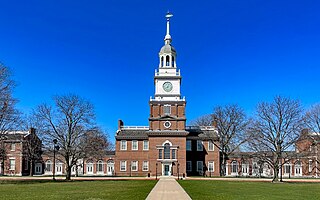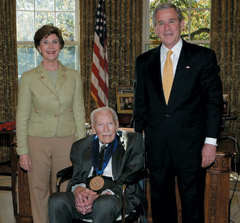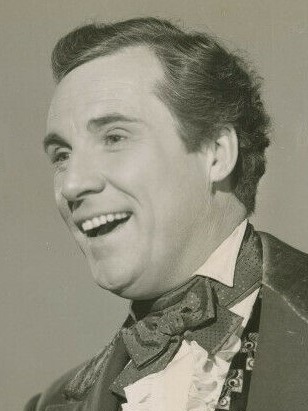
Elektro is a robot built by J.M. Barnett, Jack Weeks Sr., Harold Gorsuch, [1] and other engineers at the Westinghouse Electric Corporation 's Mansfield, Ohio, facility between 1937 and 1938.

Elektro is a robot built by J.M. Barnett, Jack Weeks Sr., Harold Gorsuch, [1] and other engineers at the Westinghouse Electric Corporation 's Mansfield, Ohio, facility between 1937 and 1938.
Seven feet tall (2.1 m), weighing 265 pounds (120 kg), humanoid in appearance, he could walk by voice command, speak about 700 words (using a 78-rpm record player), smoke cigarettes, blow up balloons, and move his head and arms. Elektro's body consisted of a steel gear, cam and motor skeleton covered by an aluminum skin. His photoelectric "eyes" could distinguish red and green light.[ citation needed ]
Elektro was on exhibit at the 1939 New York World's Fair and was joined at that fair in 1940, with "Sparko", a robot dog that could bark, sit, and beg to humans.
Several minutes of color sound footage of Elektro in action can be seen at 33:55 in the movie, The Middleton Family at the New York World's Fair , a fully-produced hour-long movie made by Westinghouse, which showcased the Westinghouse pavilion. [2]
Elektro toured North America in 1950 in promotional appearances for Westinghouse, and was displayed at Pacific Ocean Park in Ocean Park, Santa Monica, California, "which was in operation from 1958 to 1967, as part of the House of Tomorrow exhibit. [3]
Elektro appeared as "Thinko", in Sex Kittens Go to College (1960).
Sparko's fate is unknown. [1]
In the 1960s, his head was given to Harold Gorsuch, a retiring Westinghouse engineer.
In 2013, a replica was exhibited at The Henry Ford Museum in Dearborn, Michigan. [4]
Elektro is currently the subject of a property dispute by Weeks' family, Schaut's heirs and the Mansfield Memorial Museum. [5] [6] [7]

The World's Columbian Exposition, also known as the Chicago World's Fair, was a world's fair held in Chicago from May 5 to October 31, 1893, to celebrate the 400th anniversary of Christopher Columbus's arrival in the New World in 1492. The centerpiece of the Fair, held in Jackson Park, was a large water pool representing the voyage that Columbus took to the New World. Chicago won the right to host the fair over several competing cities, including New York City, Washington, D.C., and St. Louis. The exposition was an influential social and cultural event and had a profound effect on American architecture, the arts, American industrial optimism, and Chicago's image.

A Century of Progress International Exposition, also known as the Chicago World's Fair, was a world's fair held in the city of Chicago, Illinois, United States, from 1933 to 1934. The fair, registered under the Bureau International des Expositions (BIE), celebrated the city's centennial. Designed largely in Art Deco style, the theme of the fair was technological innovation, and its motto was "Science Finds, Industry Applies, Man Conforms", trumpeting the message that science and American life were wedded. Its architectural symbol was the Sky Ride, a transporter bridge perpendicular to the shore on which one could ride from one side of the fair to the other.

The Louisiana Purchase Exposition, informally known as the St. Louis World's Fair, was an international exposition held in St. Louis, Missouri, United States, from April 30 to December 1, 1904. Local, state, and federal funds totaling $15 million were used to finance the event. More than 60 countries and 43 of the then-45 American states maintained exhibition spaces at the fair, which was attended by nearly 19.7 million people.

The 1964–1965 New York World's Fair was a world's fair that held over 140 pavilions and 110 restaurants representing 80 nations, 24 U.S. states, and over 45 corporations with the goal and the final result of building exhibits or attractions at Flushing Meadows–Corona Park in Queens, New York City. The immense fair covered 646 acres (2.61 km2) on half the park, with numerous pools or fountains, and an amusement park with rides near the lake. However, the fair did not receive official support or approval from the Bureau of International Expositions (BIE).

The 1939–1940 New York World's Fair was a world's fair held at Flushing Meadows–Corona Park in Queens, New York City, United States. It was the second-most expensive American world's fair of all time, exceeded only by St. Louis's Louisiana Purchase Exposition of 1904. Many countries around the world participated in it, and over 44 million people attended its exhibits in two seasons. It was the first exposition to be based on the future, with an opening slogan of "Dawn of a New Day", and it allowed all visitors to take a look at "the world of tomorrow".

An animatronic is a mechatronic puppet. They are a modern variant of the automaton and are often used for the portrayal of characters in films, video games and in theme park attractions.

The Trylon and Perisphere were two monumental modernistic structures designed by architects Wallace Harrison and J. Andre Fouilhoux that were together known as the Theme Center of the 1939 New York World's Fair. The Perisphere was a tremendous sphere, 180 feet (55 m) in diameter, connected to the 610-foot (190 m) spire-shaped Trylon by what was at the time the world's longest escalator. The Perisphere housed a diorama by Henry Dreyfuss called Democracity which, in keeping with the fair's theme "The World of Tomorrow", depicted a utopian city-of-the-future. The interior display was viewed from above on a moving sidewalk, while a multi-image slide presentation was projected on the dome of the sphere. After exiting the Perisphere, visitors descended to ground level on the third element of the Theme Center, the Helicline, a 950-foot-long (290 m) spiral ramp that partially encircled the Perisphere.

The Henry Ford is a history museum complex in the Detroit suburb of Dearborn, Michigan, United States. The museum collection contains the presidential limousine of John F. Kennedy, Abraham Lincoln's chair from Ford's Theatre, Thomas Edison's laboratory, the Wright Brothers' bicycle shop, the Rosa Parks bus, and many other historical exhibits. It is the largest indoor–outdoor museum complex in the United States and is visited by over 1.7 million people each year. It was listed on the National Register of Historic Places in 1969 as Greenfield Village and Henry Ford Museum and designated a National Historic Landmark in 1981 as "Edison Institute".

World of Motion, presented by General Motors, was the former occupant of the transportation pavilion in Epcot at Walt Disney World Resort. It was an opening day attraction at EPCOT Center in 1982 and it closed in 1996 to make way for Test Track, a new thrill ride through a GM testing facility.

Viktor Schreckengost was an American industrial designer as well as a teacher, sculptor, and artist. His wide-ranging work included noted pottery designs, industrial design, bicycle design and seminal research on radar feedback. Schreckengost's peers included designers Raymond Loewy, Norman Bel Geddes, Eva Zeisel, and Russel Wright.

Raymond Earl Middleton was an American singer and stage, TV and movie actor.

The National Electronics Museum, located in Linthicum, Maryland, displays the history of the United States defense electronics. The museum houses exhibits containing assortments of telegraphs, radios, radars and satellites. Located near the Baltimore/Washington International Airport and rail station, the museum displays hands-on electronics. The library serves as a research center open to the public. In addition, an amateur radio station is broadcast live from the museum each week. K3NEM/W3GR includes both antique and updated communication equipment.

The Westinghouse Time Capsules are two time capsules prepared by the Westinghouse Electric & Manufacturing Company. One was made in 1939 and the other in 1965. They are filled with contemporary articles used in the twentieth century way of life in the United States. The items are intended for people of the 7th millennium to receive for historical significance.

Blanca Li, originally Blanca María Gutiérrez Ortiz is a Spanish choreographer, film director, dancer, and actress.

Robots of the United States include simple household robots such as Roomba to sophisticated autonomous aircraft such as the MQ-9 Reaper that cost 18 million dollars per unit. The first industrial robot, robot company, and exoskeletons as well as the first dynamically balancing, organic, and nanoscale robots originate from the United States.

The Middleton Family at the New York World's Fair is a 1939 American film directed by Robert R. Snody produced by Westinghouse for their exhibit at the 1939 New York World's Fair.

Eric was the first British robot, built in 1928 by First World War veteran Captain William Richards, and aircraft engineer Alan Reffell. He was constructed to open the Exhibition of the Society of Model Engineers at London's Royal Horticultural Hall in 1928, after George VI cancelled and an exasperated Richards, the exhibition's secretary, offered to "make a man of tin" to take the Duke's place. At the event's opening, Eric rose to his feet, bowed and gave a four-minute opening address.

The Nimatron was an electro-mechanical machine that played Nim. It was first exhibited in April–October 1940 by the Westinghouse Electric Corporation at the 1939-1940 New York World's Fair to entertain fair-goers. Conceived of some months prior by Edward Condon and built by Gerald L. Tawney and Willard A. Derr, the device was a non-programmable digital computer composed of electro-mechanical relays which could respond to players' choices in the game in a dozen different patterns. The machine, which weighed over a metric ton, displayed four lines of seven light bulbs both in front of the player and on four sides of an overhead cube. Players alternated turns with the machine in removing one or more lights from one of the rows until the lights were all extinguished. The calculations were purposely delayed to give the illusion that the machine was considering moves, and winners received a token.

The Christiana Riot, also known as Christiana Resistance, Christiana Tragedy, or Christiana incident, was the successful armed resistance by free Blacks and escaped slaves to a raid led by a federal marshal to recover four escaped slaves owned by Edward Gorsuch of Maryland. The raid took place in the early morning hours of September 11, 1851, at the house in Christiana, Pennsylvania, of William Parker, himself an escaped slave. This took place after the federal Fugitive Slave Act of 1850 increased penalties for assisting escaped slaves and required state government officials, even in free states such as Pennsylvania, to assist in the recapture of slaves.

The Mansfield Memorial Museum, originally Soldiers and Sailors Memorial Hall, is in downtown Mansfield, Ohio. It was founded in 1887 and opened to the public in 1889 as the Soldiers and Sailors Memorial Hall. The museum's collections include various exhibits including Native American artifacts, American Civil War memorabilia, and collections from Asia and Africa. The museum originally housed a library and theater. Oscar Cobb of Chicago designed the building. The building was built by noted architect F.F. Schnitzer, and is listed on the National Register of Historic Places.